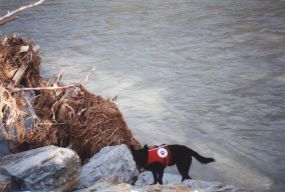
|
Why search dogs?
No matter in which country in the world the earth trembled again, it is the same situation which the rescue forces find again and again: Cities and places are destroyed, roads are impassable, heavy clearing device are not available and the telephone networks are destroyed. With simplest aids must be looked up for the buried ones and often must be dug with bare hands for the missed ones. Only few wheeled loaders and cranes are available. Also at professional salvage teams it lacks. Belonging one and neighbours are usually placed on itself alone with the search. Everyone who has already been once in this situation, knows how difficult it is to find the missed one. Often it helps to call again and again after the missed one and hope for a sign of life. But the noise of the machines makes it often not possibly to hear the calls of the missed one, thick rubble laying over the missed one prevents that the calls of the missed are not heard and unconscious victim are not any longer able to react to the calls of the search crews. Therefore the rubble must be eliminated unmethodically, until somebody finds the missed one by coincidence. But this costs valuable time. If the search squads would know directly where the missed one is, they could dig really faster and save him within the 100 hours period - many more victims could be saved. 100 hours after an earthquake there are almost no more chances of survival in the rubble. Even intact victims get after 72 hours physical damage, by hurt victims already counts each minute.
But there are which possibilities to localize the buried ones?
Calls and knocking Advantages: This possibility is always given and no specialists are needed. Disadvantages: If the victim is too deeply situated under the rubble his calls or knocking cannot be heard. It must always be relatively calmly in the environment to hear the calls of the victim. Unconscious ones and dead ones cannot answer on the calls and knocking of the search crews.
Technical locators Acoustic devices Advantages: A missing one can be localized accurately. Disadvantages: Only a few countries and rescue parties have such devices. The devices are expensive and the search crews must be trained for the use of the devices. It must be calm in the environment, so that it can operate accurately (machines to have stored, other search crews must leave the rubble and interrupt their work). Dead or unconscious victims cannot be located, the distinction between the noises of humans or animals are difficult.
Warms devices Advantages: A missing one can be localized accurately. Disadvantages: Only a few countries and rescue parties have such devices. The devices are expensive and the search crews must be trained for the use of the devices. Other heat sources (fires and heat) falsify the detection signals.
Search cameras Advantages: A missing one can be localized accurately, often is also possible over an inserted microphone to contact the victim. Disadvantages: Only a few countries and rescue parties have such devices. The devices are expensive and the search crews must be trained for the use of the devices. The application of the cameras is only possible if in the rubble are columns into which the cameras can be introduced.
Bio radar Advantages: A missing one can be localized accurately. Disadvantages: Only a few countries and rescue parties have such devices. The devices are expensive and the search crews must be trained for the use of the devices. Several search teams are needed for the operation of the bio radar. The device cannot differentiate between humans and animals.
All technical devices are only conditionally applicable. External influences (current, weather, volume, heat, water) obstruct the application of the devices. If the device is defective or no sufficiently trained operating personnel is available, the respective device cannot be used. The search with technical devices is very time-consuming.
Search and rescue dogs Advantages: Search dogs are cheap compared with technical devices. Search dogs can be used always and everywhere. External influences (weather, heat, cold weather, machines, humans, animals) do not impair the dogs in the search. The other search crews do not have to interrupt their work during the application of the dogs. The localization of the victims takes very fast and surely (importantly faster than with technical devices) place. The dogs can look up also under the rubble. The dogs can find living persons and dead victims and differentiate between humans and animals. The dogs can find also humans who are deeply under the rubble. The dogs are very mobile in the use and can be used fast at other destroyed buildings. Only one dog replaces more than 50 auxiliary workers. Disadvantages Only few countries have own search dogs. The formation of the dogs takes 1-2 years.
From all the aids that are available, the dogs are most effective and should be alarmed therefore as fast as possible. Many buried ones owe their life to the dogs. However the application of the dogs is only meaningful if they are very promptly alarmed, because it takes some time until the teams from other countries can arrive in the seismic zone.
|
.jpg)



